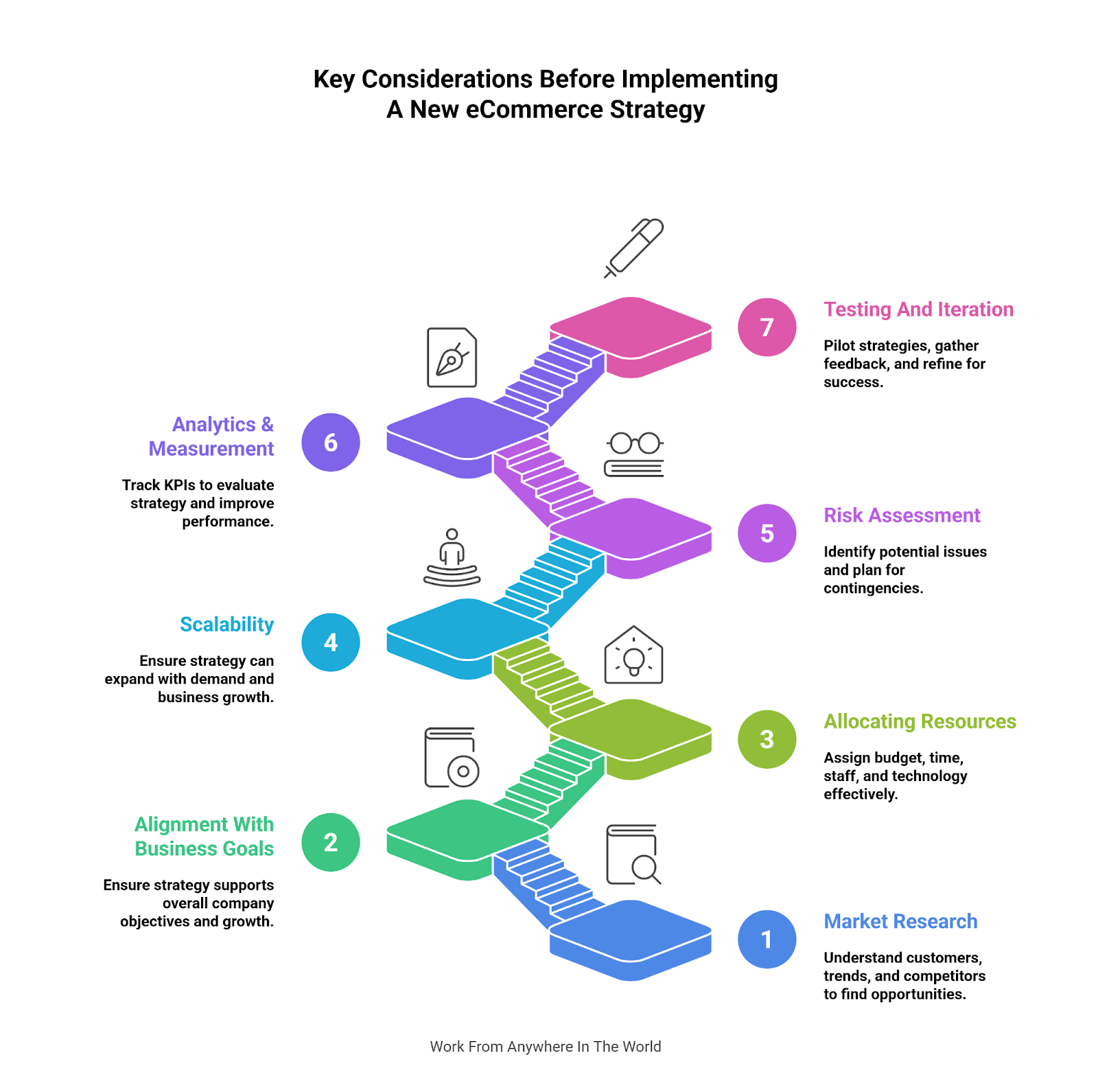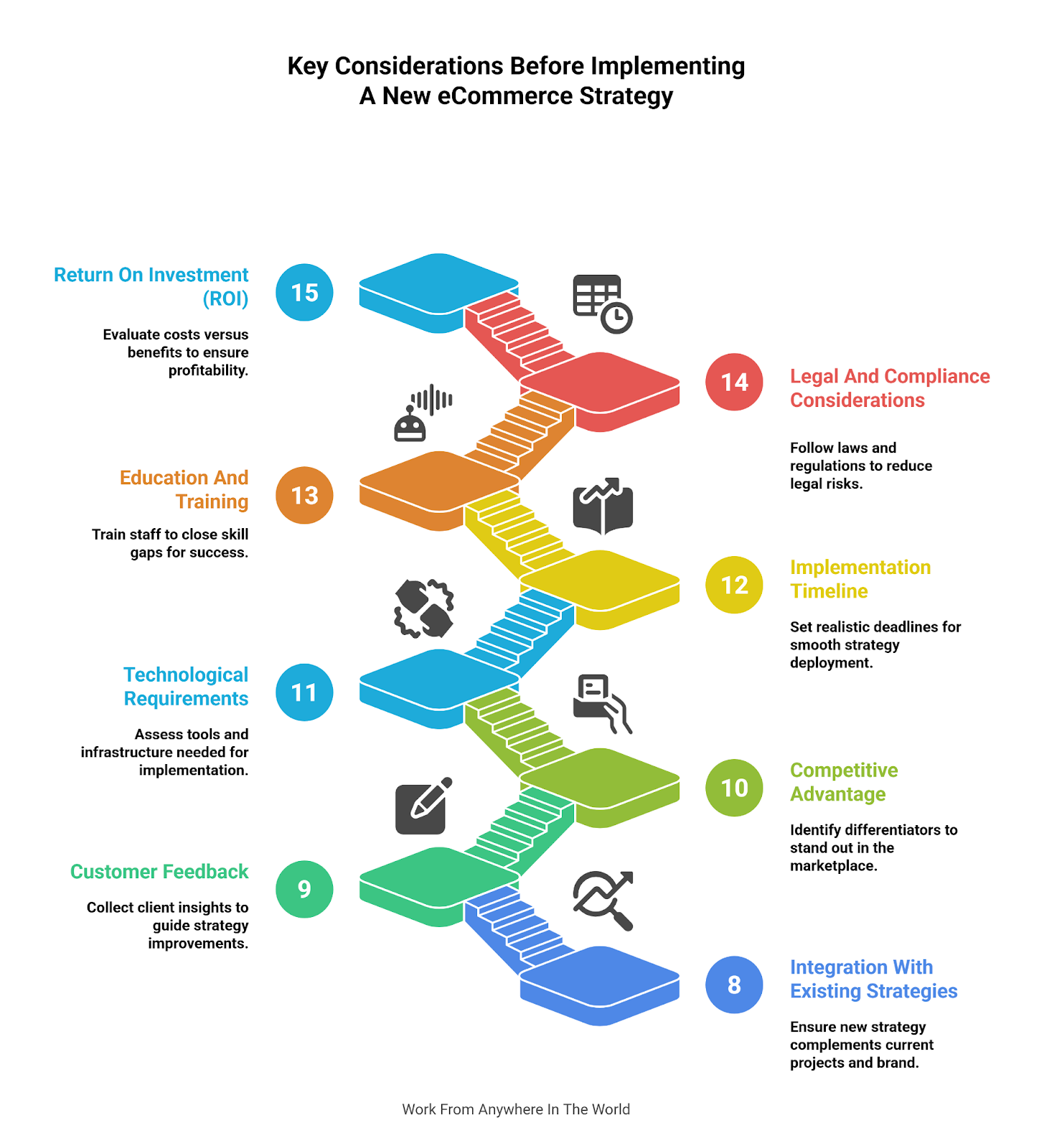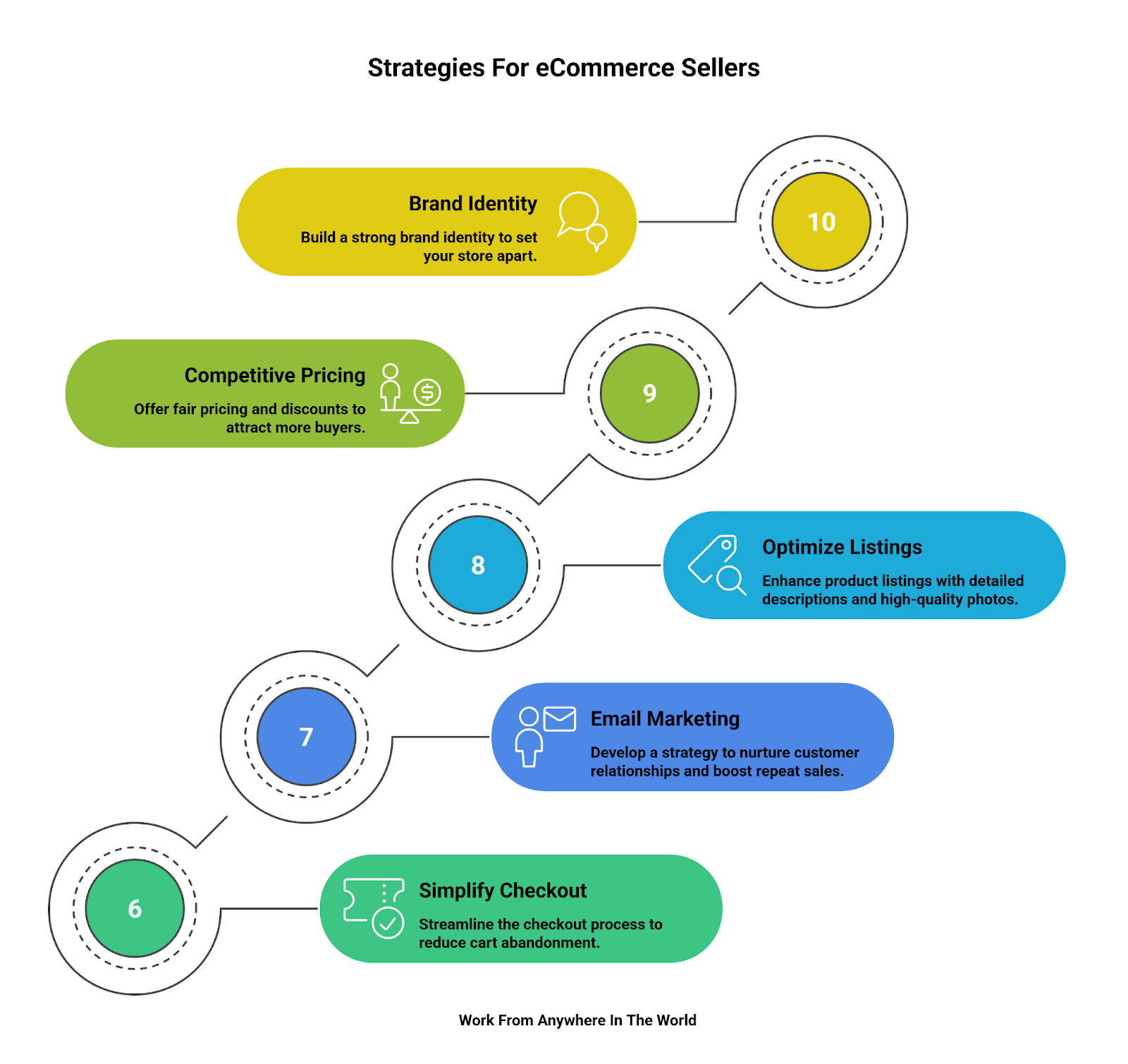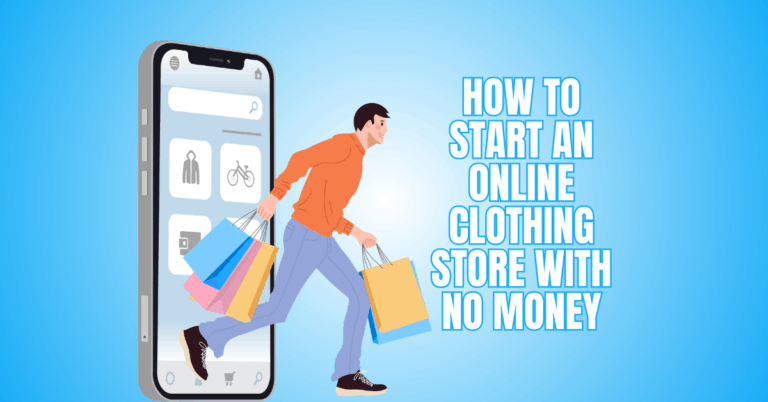Best Strategies For eCommerce Sellers
Your small business can reach new heights by utilizing the appropriate e-commerce methods. With no expense, it can assist you in generating leads and revenues.
93.5% of internet users have bought anything online, according to OptinMonster. The number makes it clear how profitable an online store can be.
This article will explore some of the best strategies for eCommerce sellers to adopt to boost their online presence, increase sales, and establish a sustainable business model.
From optimizing product listings to leveraging social media marketing and providing exceptional customer service, we will delve into the key pillars contributing to e-commerce ventures' success.
Key Considerations Before Implementing A New eCommerce Strategy
It's essential to undertake an in-depth study and analysis before considering implementing a new e-commerce strategy to ensure its viability and potential for success.
Before implementing a new eCommerce strategy, take into account the following significant factors:
1. Market Research
Develop a thorough understanding of your target market's tastes, demands, and buying habits. Determine any gaps or opportunities your new strategy can substantially impact by examining market trends, rival tactics, and consumer feedback.
2. Alignment With Business Goals
Consider how the new strategy fits into the bigger picture of your company's goals. Will it assist you in developing new markets, enhancing client engagement, or boosting sales?
Ensure the plan is connected to your company's objectives and the capacity to produce significant outcomes.
3. Allocating Resources
Determine the resources needed to implement the new strategy successfully. Budget, time, staff, and technological skills are a few considerations.
To support the execution of the plan, ascertain whether you already have the required resources in place or need to make changes or investments.
4. Scalability
Consider the new strategy's capacity for expansion. Will it hold up and be flexible as your firm expands? Make sure that the plan can, over time, handle rising demand, increasing sales volumes, and changing client expectations.
5. Risk Assessment
Assess risks related to the new plan. Determine problems or restrictions that might emerge during implementation. Consider the effects on your brand's reputation, patient experience, and financial security. Create backup plans.
6. Analytics And Measurement
Choose the metrics you'll use to gauge the effectiveness of the new approach. Set up key performance indicators (KPIs) that follow pertinent criteria and align with your company's goals.
Create a system for gathering and evaluating data so that you can assess the strategy's success and make data-driven decisions for continuous improvement.
7. Testing And Iteration
Before implementing the new approach on a bigger scale, consider performing small-scale tests or pilot programs to gauge the effectiveness and impact.
This enables you to gather input, pinpoint areas for improvement, and make the required adjustments before devoting significant resources.

8. Integration With Existing Strategies
Consider how the new strategy will work with your current e-commerce projects. To avoid conflict or compromising your overall brand message and consumer experience, be sure it enhances and supplements your current efforts.
9. Customer Feedback
Gather information from your current clientele through surveys, interviews, or other feedback mechanisms. Know what they want, what they want, and what they expect.
To ensure your new approach connects with your target audience, consider their comments as you build and tweak it.
10. Competitive Advantage
Examine the new strategy's potential to give you a competitive advantage in the marketplace. Find out what differentiates you from your rivals and how the new system can make the most of your USPs.
Determine how it can help your company stand out from the competition and draw clients in a crowded market.
11. Technological Requirements
Determine whether the new plan needs special technological equipment or infrastructure. Ask yourself if your current e-commerce platform or systems can support the implementation.
Decide whether to develop integrations or invest in new technologies to implement the strategy effectively.
Wealthy Affiliate – Mini Review (2025)
If you’ve ever thought about turning your blog, passion, or niche into an online business,
Wealthy Affiliate (WA) is one of the most beginner-friendly platforms I’ve used.
It combines step-by-step training, website hosting, SEO research tools,
and an active community all in one place.
What I like most: you can start free (no credit card needed),
explore lessons, test the tools, and connect with other entrepreneurs
before upgrading. WA isn’t a “get rich quick” scheme — it’s a platform where success comes
from consistent effort and applying what you learn.
12. Implementation Timeline
Establish a reasonable deadline for implementing the new approach. Take into account the time needed for preparation, implementation, and monitoring.
To ensure a smooth and timely deployment, allocate resources and establish milestones. Avoid speeding the implementation phase because doing so could undermine the strategy's quality and efficacy.
13. Education And Training
Determine whether your staff needs more instruction or training to implement the new plan successfully.
Determine any skill gaps and give your team the resources or training they need to succeed. Make sure that each participant is aware of the goals of the plan, their responsibilities, and the anticipated results.
14. Legal And Compliance Considerations
Examine any legal or compliance specifications associated with the new plan. Ensure you abide by all relevant laws and rules, such as those about consumer protection, data privacy, and the security of online payments. To ensure compliance and reduce potential legal risks, seek legal advice as needed.
15. Return On Investment (ROI)
Examine the new strategy's prospective ROI. Calculate the expected revenue or cost savings the plan may produce and the expenses related to putting it into practice and keeping it up.
Perform a cost-benefit analysis to determine whether the advantages outweigh the investment needed.
By considering these additional factors, you can comprehensively evaluate a new e-commerce strategy, set realistic expectations, and increase the chances of a successful implementation that positively impacts your business.

Best Strategies For eCommerce Sellers
Running an eCommerce store is exciting but competitive. Success depends on innovative strategies that attract customers, boost sales, and build long-term growth. Here are the best strategies for eCommerce sellers.
1. Focus on Mobile Optimization
With most shoppers using smartphones, mobile optimization is no longer optional—it’s a necessity. A mobile-first design ensures customers enjoy a smooth experience, encouraging them to complete purchases.
Responsive layouts, fast load times, and simplified checkout processes are critical. Regular testing on different devices helps identify and fix issues before they affect sales.
Since Google prioritizes mobile-friendly websites, improving mobile usability also boosts SEO rankings.
By creating a mobile-optimized store, you increase engagement, trust, and conversion rates while staying competitive in today’s digital marketplace.
Key Points
- Ensure your store uses a responsive design for all screen sizes.
- Optimize website speed for faster mobile browsing.
- Simplify navigation with large buttons and clear menus.
- Test across devices to fix display or functionality issues.
2. Invest In SEO And Content Marketing
When people search for products, Search Engine Optimization (SEO) makes sure your store shows up in the results. Optimized product titles, descriptions, and images improve visibility.
Content marketing adds extra value by educating and engaging shoppers. Blogs, videos, and guides not only drive organic traffic but also position you as an authority in your niche.
Over time, SEO reduces reliance on paid ads while steadily increasing brand visibility. A consistent strategy combining SEO with content creation helps build trust, attract new audiences, and keep customers coming back for more.
Key Points
- Use targeted keywords in product descriptions and titles.
- Create helpful blogs and guides that solve customer problems.
- Optimize images with alt tags for better search rankings.
- Build backlinks from reputable websites to increase authority.
3. Leverage Social Media Marketing
Social media platforms have become powerful eCommerce sales channels. Sellers can showcase products, build communities, and drive targeted traffic with creative content. Instagram reels, TikTok videos, and Facebook ads help grab attention quickly.
Influencer partnerships and user-generated content increase credibility while boosting brand exposure. Building relationships and increasing recurring business can be done at a low cost using email marketing.
By posting consistently and running well-targeted campaigns, you can build loyal followers who convert into long-term buyers, making social media an essential tool for eCommerce success.
Key Points
- Post engaging content such as reels, stories, and live sessions.
- Collaborate with influencers to expand reach and credibility.
- Encourage user-generated content for trust and authenticity.
- Run paid ads with precise audience targeting.
4. Offer Excellent Customer Service
Customer service is the foundation of any successful eCommerce business. Providing fast responses, clear policies, and easy returns improves trust and loyalty. Live chat or chatbots can assist customers instantly, reducing abandoned carts.
Going the extra mile with personalized follow-ups, thank-you emails, and discounts encourages repeat purchases. Excellent customer service not only creates satisfied buyers but also generates positive reviews and referrals.
A strong reputation for customer care gives your store a competitive edge, turning first-time visitors into long-term, loyal customers who keep coming back.
Key Points
- Provide quick responses through live chat or chatbots.
- Maintain clear shipping and return policies.
- Personalize communication with follow-up messages.
- Encourage reviews to build trust and credibility.
5. Use Data And Analytics To Drive Decisions
Data analytics allows sellers to make informed choices instead of relying on guesswork. Tracking metrics like conversion rates, best-selling products, and traffic sources reveals valuable insights.
Tools such as Google Analytics help identify customer behaviours and optimize marketing strategies. A/B testing product pages, ads, and emails improves results over time. Data also helps plan inventory and predict seasonal demand, reducing waste.
By making data-driven decisions, sellers maximize profits, cut losses, and continuously improve their online store. Analytics ensures that every move is backed by evidence and customer insights.
Key Points
- Track key metrics such as traffic, conversions, and sales trends.
- Use Google Analytics or similar tools for insights.
- Run A/B tests to refine ads, emails, and landing pages.
- Plan inventory based on data to avoid overstocking.

6. Simplify The Checkout Process
A complicated checkout is one of the top reasons shoppers abandon carts. Streamlining the process ensures more completed purchases.
Offering guest checkout reduces friction, while displaying total costs upfront avoids unpleasant surprises. Providing multiple payment methods caters to customer preferences.
Security signals, such as SSL certificates and trust badges, reassure buyers. A smooth, secure, and fast checkout encourages customers to finish their purchase and return for more.
By minimizing obstacles at this stage, sellers can significantly increase conversions and revenue while building customer confidence in their store.
Key Points
- Allow guest checkout without mandatory account creation.
- Show total costs clearly before payment.
- Offer diverse payment options like PayPal and wallets.
- Add trust badges for secure transactions.
7. Build An Email Marketing Strategy
Building relationships and increasing recurring business can be done at a low cost using email marketing. Unlike social media, emails reach customers directly, free from algorithm limitations.
Personalized messages, product recommendations, and abandoned cart reminders increase engagement. Segmenting email lists by customer behaviour ensures relevant communication.
Automated campaigns save time while maintaining consistency. Over time, effective email marketing builds loyalty, drives conversions, and keeps your brand top-of-mind.
It’s a powerful tool for maintaining long-term customer connections and encouraging repeat purchases, making it essential for eCommerce growth.
Key Points
- Send personalized emails with offers and recommendations.
- Use abandoned cart reminders to recover lost sales.
- Segment email lists by customer behaviour.
- Automate campaigns for consistency and efficiency.
8. Optimize Product Listings And Photos
Shoppers rely heavily on product listings and visuals when deciding to buy online. Detailed, benefit-driven descriptions highlight product value and reduce doubts.
High-quality photos from multiple angles give customers a better view, while lifestyle images show products in real use.
Adding videos or 360-degree views further boosts confidence. Clear listings improve SEO, helping your products rank higher in searches.
Well-optimized product pages not only increase conversions but also reduce return rates by setting realistic expectations. A good presentation can make the difference between losing and winning a sale.
Key Points
- Write benefit-focused product descriptions.
- Use multiple high-quality images from different angles.
- Add lifestyle photos and demonstration videos.
- Optimize listings with keywords for better search results.
9. Offer Competitive Pricing and Discounts
Pricing strongly influences purchasing decisions, but competing solely on price isn’t sustainable. Instead, combine fair pricing with added value.
Bundle offers, free shipping, and loyalty rewards attract more buyers without sacrificing profits. Flash sales and seasonal discounts create urgency, motivating quick purchases.
Transparent pricing builds trust, while regular competitor research ensures you remain competitive. A balanced approach keeps customers satisfied and encourages repeat purchases.
Innovative pricing strategies not only drive immediate sales but also strengthen your brand’s reputation for fairness and value in the marketplace.
Key Points
- Research competitor pricing to stay competitive.
- Offer bundle deals and free shipping incentives.
- Run flash sales and seasonal discounts.
- Use loyalty rewards to encourage repeat purchases.
10. Build Strong Brand Identity
In a congested eCommerce market, having a strong brand identity helps you stand out. Branding is more than just a logo; it also involves your story, values, colours, and tone. A clear and consistent brand voice builds emotional connections and customer trust.
Sharing your mission or behind-the-scenes content makes your store relatable and authentic. Consistency across social media, packaging, and customer interactions reinforces recognition.
Over time, a well-developed brand identity encourages loyalty, making customers return not just for products but also for the values your brand represents. Strong branding transforms buyers into advocates who promote your business.
Key Points
- Develop a consistent logo, colour scheme, and tone.
- Share your mission and brand story to build authenticity.
- Maintain consistency across all platforms and packaging.
- Create emotional connections that turn buyers into loyal fans.

Conclusion
In conclusion, e-commerce merchants can use a variety of tactics to improve their online presence and foster success.
Sellers can raise their brand awareness, customer engagement, and conversion rates by improving product listings, expediting checkout, utilizing social media marketing, concentrating on user reviews and ratings, and implementing other successful strategies.
E-commerce sellers may stay ahead of the curve and consistently provide an improved online shopping experience by continuously evaluating data, monitoring key performance indicators, and modifying strategy accordingly.
In the changing world of e-commerce, adopting these best practices and remaining innovative will position sellers for growth, customer satisfaction, and higher revenue.
A proper marketing plan may help you reach more potential customers, raise the average order value, and boost your sales. All of these are areas that you want to work on, definitely.
You can construct a profitable store that offers customers a positive shopping experience and is equally enjoyable and rewarding for you to run by paying attention to the e-commerce marketing advice provided above.
I trust you enjoyed this article on the Best Strategies For eCommerce Sellers. Please stay tuned for more insightful blogs on affiliate marketing, online business, and working from anywhere in the world.
Take care!
— JeannetteZ
💬 Your Opinion Is Important To Me
Do you have thoughts, ideas, or questions? I’d love to hear from you. Please leave your comments below or email me directly at Jeannette@WorkFromAnywhereInTheWorld.com.
📚 More Work From Anywhere Reads
🚀 Ready to Build a Business You Can Run from Home
Or from Anywhere in the World?
Imagine creating income on your terms — from home, a cozy café, or wherever life takes you.
With the right tools, training, and community support, it’s entirely possible.
Start your own online business for free — no credit card needed.
Disclosure
This post may contain affiliate links. As an Amazon Associate and participant in other affiliate programs, I earn from qualifying purchases at no extra cost to you. Please read my full affiliate disclosure.







